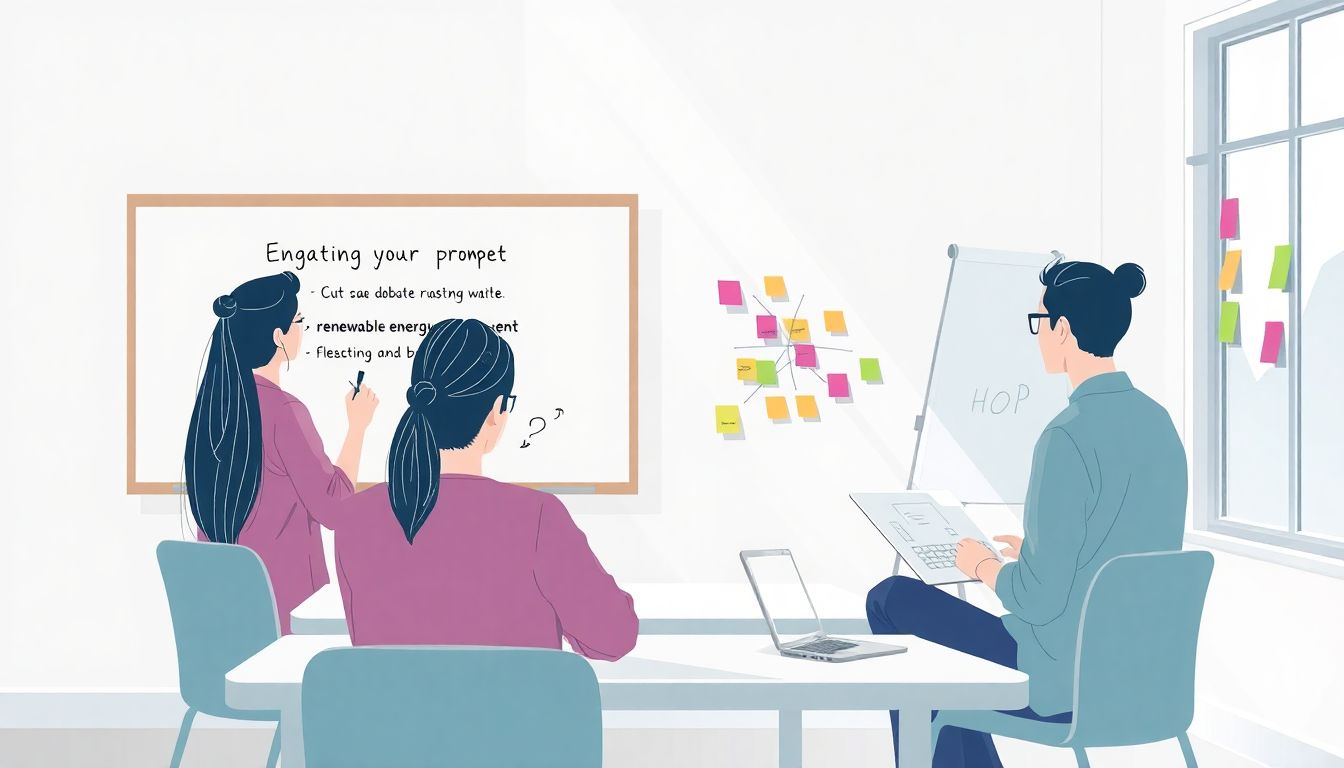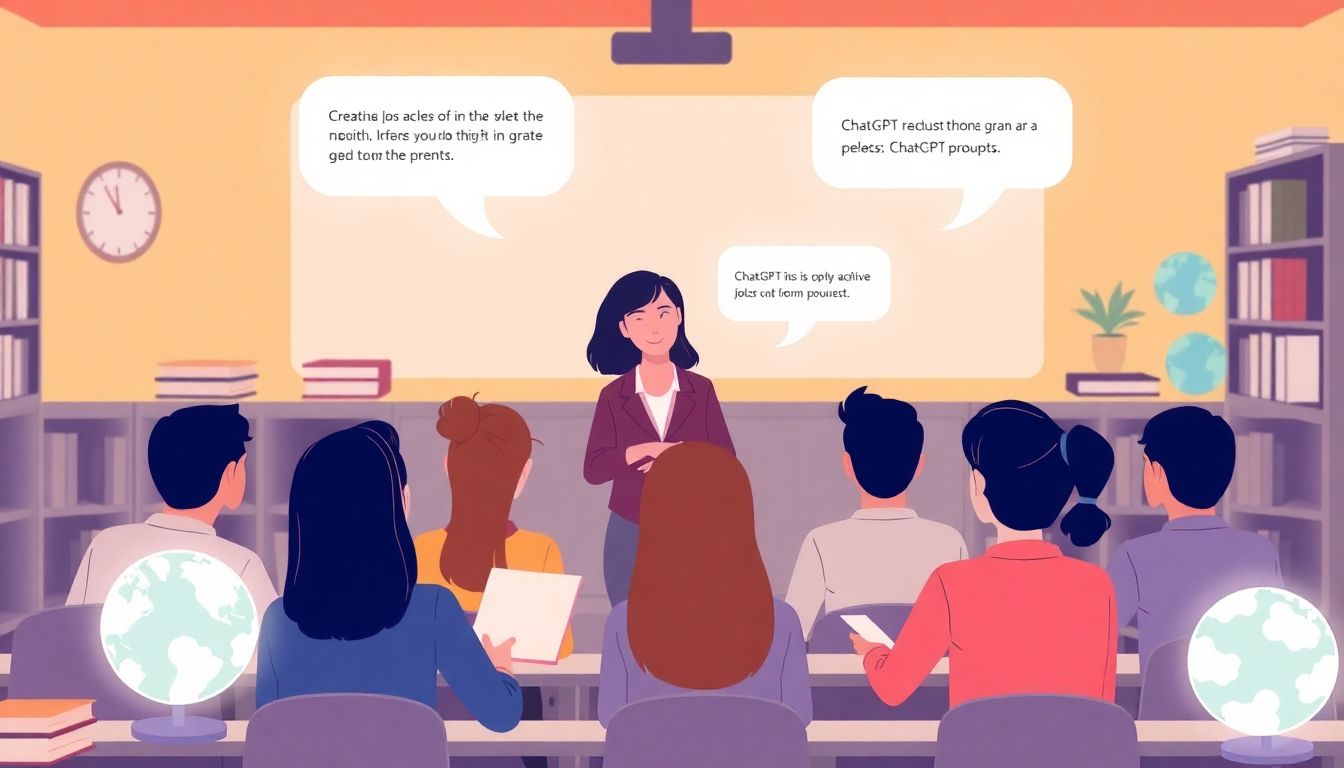If you’ve ever struggled to come up with engaging and effective prompts for problem-based learning scenarios, you’re not alone. Many educators find it tricky to create scenarios that both challenge and inspire students. It can be frustrating when you know your learners are capable of so much more, but the right prompt just seems out of reach.
But don’t worry! In this blog, you’ll discover how ChatGPT can be your secret weapon for crafting creative prompts that spark curiosity and collaboration among students. By harnessing the power of AI, you can transform your lesson plans and capture your students’ attention like never before.
We’ll dive into a range of topics—from crafting the perfect prompt to overcoming common challenges in problem-based learning. Get ready to unearthed some game-changing tips that’ll elevate your teaching efforts!
Key Takeaways
- Use ChatGPT to create tailored problem-based learning prompts that engage students and spark curiosity.
- Effective prompts can cover real-world issues, historical events, and collaborative projects.
- Ensure prompts align with learning objectives and encourage exploration and teamwork.
- Iterate on prompts based on student feedback to enhance engagement.
- Address common challenges in PBL, like complexity and student disengagement, with appropriate prompts.
- Incorporate interactive elements and storytelling to boost student interest.
- Leverage feedback and assessment prompts to support student growth and reflection.

Effective ChatGPT Prompts for Problem-Based Learning Scenarios
Problem-based learning (PBL) thrives on real-world challenges that encourage critical thinking and collaboration.
Using ChatGPT to create effective prompts can enhance these learning experiences significantly.
Here are some effective ChatGPT prompts that you can use directly in your learning scenarios:
- “Generate a real-world problem related to climate change that requires a multidisciplinary approach to solve.”
- “Create a scenario where students must navigate a business crisis, emphasizing teamwork and communication skills.”
- “Suggest a historical event that can be turned into a problem-based learning exercise, including key questions for students to explore.”
- “Propose a community service project that addresses a local issue, outlining steps for students to plan and implement the project.”
These prompts can be tailored to suit different learning objectives and subject areas, making them versatile tools for educators.
How to Create Problem-Based Learning Prompts with ChatGPT
Creating effective problem-based learning prompts with ChatGPT involves a few straightforward steps.
First, clearly define the learning objectives you want to achieve.
Ask ChatGPT for tailored prompts by providing context, such as the subject and relevant challenges.
Example command: “Create a problem-based learning prompt for high school biology that involves genetics.”
Next, ensure the prompt encourages students to ask guiding questions and explore solutions collaboratively.
A good prompt might be: “Design an experiment to test the effects of pollution on local wildlife populations and discuss the implications.”
Finally, refine your prompts based on student feedback and adjust as necessary to improve engagement.
Examples of Problem-Based Learning Scenarios Using ChatGPT
There are numerous ways to utilize ChatGPT for crafting engaging problem-based learning scenarios.
For instance, you can develop case studies by generating prompts that simulate real-life situations.
One example could be: “Simulate a town hall meeting where stakeholders must discuss the implications of a new policy on education.”
Another engaging scenario could revolve around role-playing: “Role-play as a member of an environmental organization tasked with convincing a city council to adopt sustainable practices.”
By incorporating cross-disciplinary themes, prompts like, “Generate a scenario where students from different majors must collaborate to solve a food distribution issue in a crisis,” will enhance interaction.
These scenarios not only promote critical thinking but also facilitate teamwork and communication skills.
Benefits of Using ChatGPT for Problem-Based Learning
Integrating ChatGPT into problem-based learning offers several benefits that can enhance educational outcomes.
For starters, it boosts critical thinking by presenting complex problems that require thoughtful analysis and discussion.
Prompts from ChatGPT can improve problem-solving skills as students work through authentic challenges.
Moreover, using AI can help create personalized learning experiences, catering to diverse learner needs.
Students also gain the advantage of immediate feedback, allowing for quick adjustments in their understanding.
This autonomy empowers learners, making them feel more in control of their educational journey.
For those interested in writing, you can explore techniques to enhance creativity with AI through prompts designed for creative writing. Check out our post on creative writing prompts for inspiration!
By adopting ChatGPT in your teaching strategy, you’re not just keeping up with modern education techniques; you’re shaping future thinkers.

Best Practices for Designing Learning Prompts with ChatGPT
Designing effective learning prompts with ChatGPT is key to maximizing student engagement and learning outcomes.
Start by ensuring your prompts are clear and concise.
A good example of a concise prompt is: “Create a debate scenario focused on renewable energy sources where students must argue for or against implementation.”
Next, align your prompts with specific learning objectives.
For example, if you want students to understand economic principles, try: “Draft a business proposal for starting a local eco-friendly product line.”
Consider formatting your prompts for better readability, breaking them into lists or questions.
An engaging prompt might look like: “Identify three major environmental issues in your city. Discuss potential solutions and their societal impacts.”
Iterate on your prompts, gathering student feedback to enhance their effectiveness.
Don’t forget to tweak prompts based on the student’s learning level for maximum impact!
Common Challenges in Problem-Based Learning and How ChatGPT Can Help
Problem-based learning (PBL) can present various challenges, but ChatGPT can help address them effectively.
One common issue is students struggling to grasp complex topics.
Try this prompt: “Provide a simplified overview of the scientific method designed for middle school students.”
Another challenge is student disengagement during group tasks.
You can combat this with: “Create a scenario where each group member has a specific role in solving a community health issue.”
Overcoming barriers to collaboration is also crucial.
Use prompts like: “Draft a plan where students from varied backgrounds must work together on an environmental project.”
Finally, facilitating diverse learner needs can be demanding.
As a solution, ask ChatGPT: “Generate a diversity-focused project that encourages inclusivity in the classroom.”
Tips for Enhancing Engagement in Problem-Based Learning with ChatGPT
Engagement is at the heart of effective problem-based learning, and using ChatGPT can significantly enhance it.
Incorporate storytelling elements into your prompts.
A great starter might be: “Craft a narrative where students become detectives solving a local mystery related to environmental conservation.”
Use interactive elements like gamification to motivate your learners.
For instance: “Design a game where students earn points for each sustainable solution they propose.”
Encourage collaboration with prompts that require teamwork.
Example: “Create a presentation about a historical figure that students can work on in pairs.”
To maintain interest, regularly update your scenarios to reflect current events.
Try this prompt for inspiration: “Outline a debate on a recent environmental law change and how it impacts their community.”
All these strategies turn a basic lesson into an engaging learning experience!
Feedback and Assessment Prompts for Problem-Based Learning
Integrating effective feedback and assessment prompts can greatly enhance your problem-based learning environment.
Encourage students to reflect on their learning with this prompt: “What were the three biggest lessons you learned from your last project?”
Design self-assessment prompts to encourage critical thinking: “Assess your group dynamics. What worked well, and what could improve?”
For peer evaluations, use prompts like: “Provide constructive feedback on your partner’s presentation, citing at least two strengths and one improvement suggestion.”
Incorporate formative assessments by asking: “Summarize your understanding of the problem and propose one alternative solution.”
These feedback strategies not only guide learning but also foster a growth mindset.
Regular assessments keep students engaged and accountable for their learning progress.

Integrating ChatGPT into Your Problem-Based Learning Curriculum
Integrating ChatGPT into your problem-based learning (PBL) curriculum can enhance educational effectiveness and engagement.
Start by aligning ChatGPT generated prompts with your learning objectives.
Ask ChatGPT for help in crafting assessment activities, like: “Generate assessment questions based on the renewable energy project scenario.”
Design lesson plans that incorporate interactions with ChatGPT, like: “Create a lesson outline that uses ChatGPT prompts to guide student discussions on climate change solutions.”
Train educators on using ChatGPT effectively by providing examples and best practices, such as: “Outline how to use ChatGPT to generate case studies for history classes.”
To maintain consistency, create a prompt bank that teachers can easily reference: “List ten prompts for engaging students in environmental issues.”
Encourage collaboration among educators to share their experiences and insights with ChatGPT: “Summarize best practices for integrating AI into PBL.”
This collaborative approach fosters a wider acceptance and effective use of ChatGPT in various subjects.
By embedding these practices into your curriculum, you can create a more adaptable and engaging learning environment.
FAQs
Effective prompts are clear, concise, and contextualized problems that encourage critical thinking. Use open-ended questions, real-world scenarios, and encourage collaboration to facilitate deeper learning and engagement with ChatGPT.
ChatGPT can assist by providing instant feedback, additional resources, and personalized support. It helps students clarify doubts and explore solutions effectively, making the problem-based learning process smoother.
Benefits include enhanced engagement, immediate support, personalized learning experiences, and access to a vast knowledge base. ChatGPT encourages creativity and critical thinking while allowing learners to explore diverse perspectives.
Use feedback prompts that assess understanding and application of concepts. Incorporate rubrics for qualitative evaluation and encourage peer assessment through ChatGPT to gain diverse insights into student performance.
